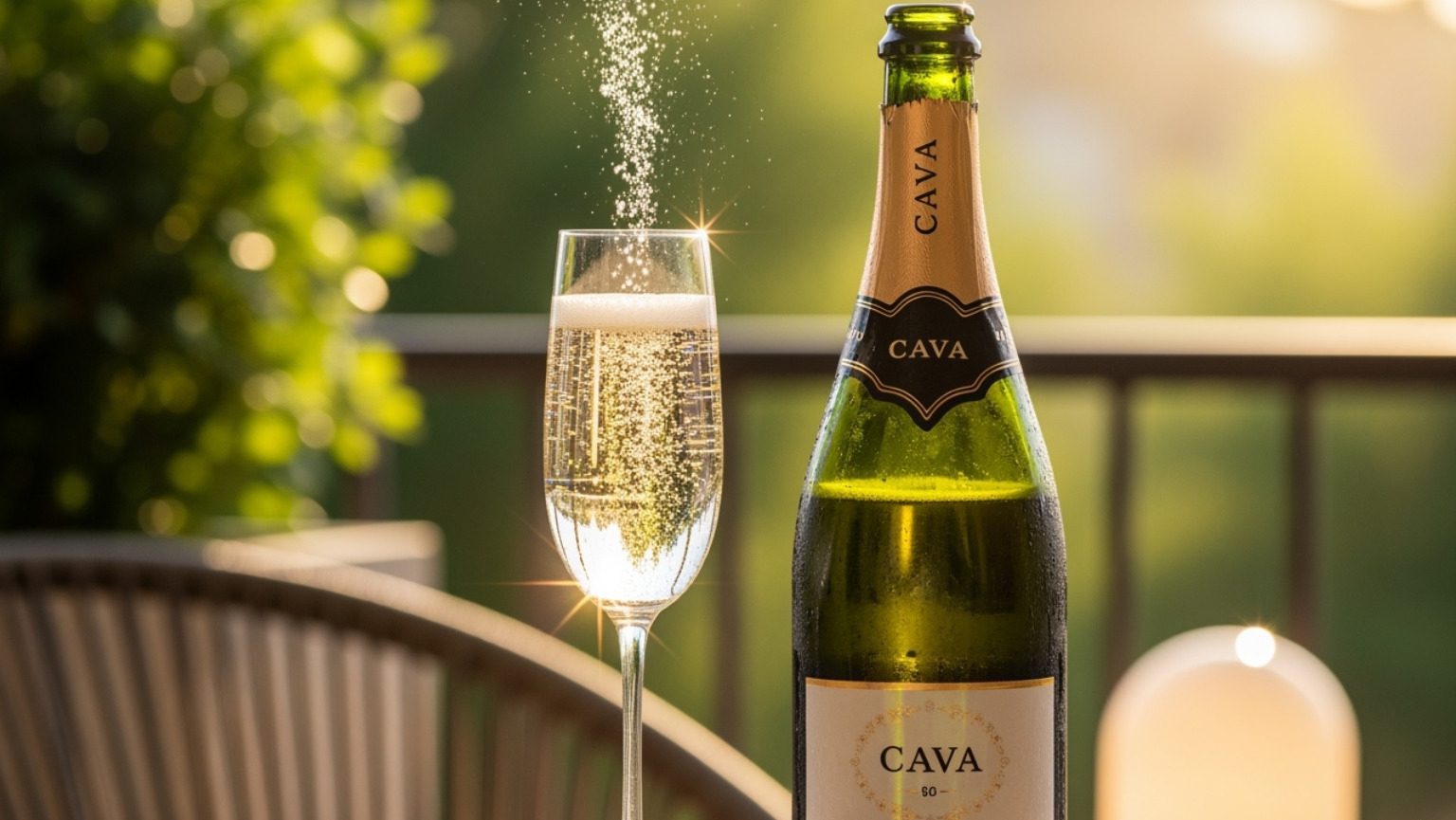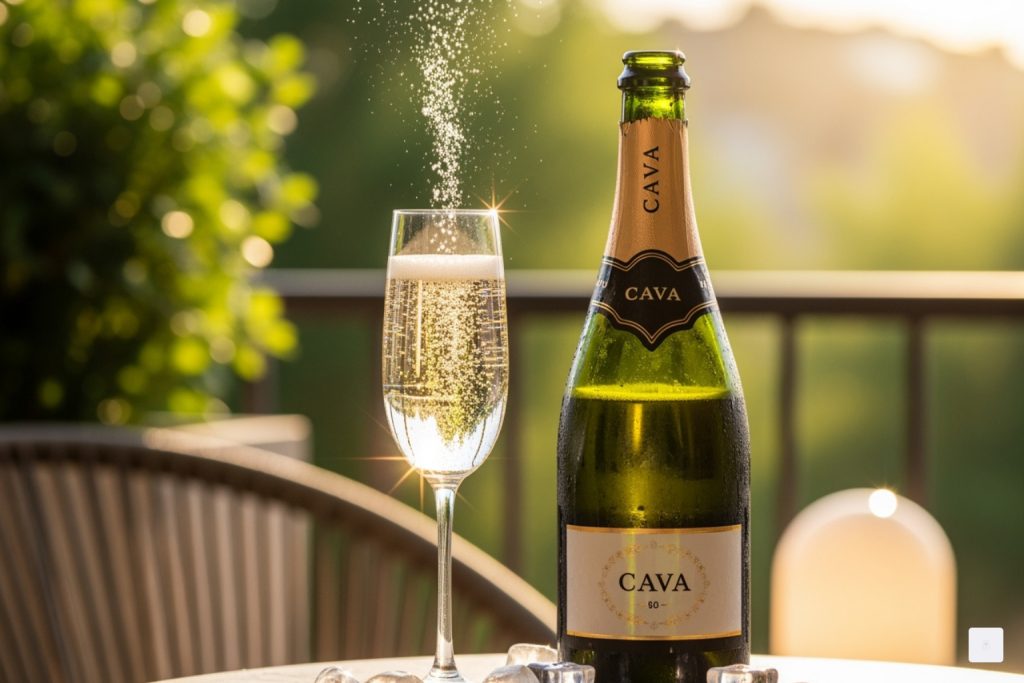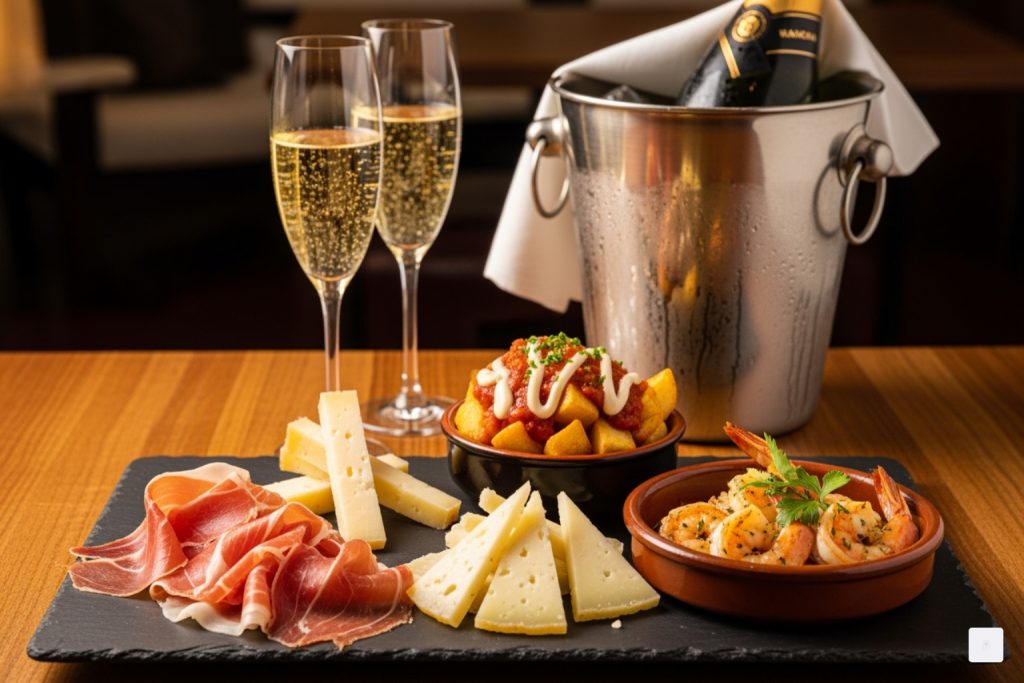
Why Cava Wine Deserves a Place at Your Table

Cava is a Spanish sparkling wine produced using the traditional method, primarily in Catalonia’s Penedès region. It offers exceptional quality at accessible prices compared to Champagne, making it perfect for celebrations or casual gatherings.
Quick Facts About Cava:
- What it is: Spanish sparkling wine with Denominación de Origen (DO) status
- Where it’s made: 95% produced in Penedès, Catalonia, Spain
- How it’s made: Traditional method (same as Champagne) with second fermentation in the bottle
- Main grapes: Macabeo, Xarel·lo, and Parellada (plus Chardonnay and Pinot Noir)
- Styles: Ranges from bone-dry Brut Nature to sweet Dulce
- Price point: Significantly more affordable than Champagne while maintaining quality
Whether you’re hosting a gala in New York City or enjoying a quiet evening at home, cava brings sophistication without pretension. It’s exported to over 100 countries, with annual production exceeding 100 million liters.
The beauty of cava lies in its versatility. It pairs brilliantly with everything from Spanish tapas to fresh oysters at a Manhattan seafood bar. The crisp acidity and neat bubbles make it equally at home at a black-tie benefit or a Sunday brunch in the West Village.
As R. Couri Hay, I’ve served cava at countless high-society events across New York and watched it win over even the most discerning palates. Its combination of Old World craftsmanship and accessible luxury makes it an insider’s secret worth sharing.
Also read:
- celebrity lifestyle insights
- azazie
- target yoghurt recall
The Origins and Soul of Spanish Cava
Cava’s story begins in the rolling hills of Catalonia, where ancient winemaking traditions meet modern innovation. It’s more than bubbles in a bottle; it’s a story of regional identity, vision, and centuries of Spanish craftsmanship.
The Penedès region in Catalonia, just southwest of Barcelona, is where the magic happens. Sun-drenched vineyards on gentle slopes meet Mediterranean breezes and mineral-rich soils. This is cava country, responsible for 95% of all Spanish sparkling wine production. At its heart is Sant Sadurní d’Anoia, the proud capital of cava, where historic bodegas line the streets and the town’s annual October festival celebrates the wine’s deep cultural roots.
The origin of cava is a wonderfully human story. In the 1860s, Josep Raventós of the Codorníu estate visited Champagne, France. Inspired by the traditional method he witnessed, he decided to bring the technique home to Spain. Raventós experimented with local grapes—Macabeo, Xarel·lo, and Parellada—and the result was a spectacular sparkling wine with a unique personality shaped by Spanish terroir. For years, it was called “Spanish Champagne,” but it was destined for its own identity.
For those who want to dive deeper into the fascinating world of Spanish sparkling wine, the Official Website of DO Cava offers extensive information about regulations, history, and production standards.
What is the Cava DO (Denominación de Origen)?
The Denominación de Origen (DO) is cava‘s official seal of authenticity, a promise that the wine meets exacting standards. To be called cava, a sparkling wine must be produced in specific Spanish regions using approved grapes and methods, including secondary fermentation in the bottle and minimum aging periods.
Cava received its DO status in 1972 and also carries the VECPRD classification, meaning “Quality Sparkling Wine Produced in a Determined Region.” These regulations protect producers and consumers alike. When you’re shopping for cava in New York City, from the Upper East Side to Brooklyn, that DO label is your assurance of quality, guaranteeing the authentic experience Spanish winemakers intended.
The Evolution of Cava
The path from Josep Raventós’s experiments to modern cava is one of innovation. After he proved Spanish grapes could create world-class sparkling wine, other regional producers joined the movement. For decades, the wines were marketed as “Spanish Champagne,” but as European Union law began protecting geographical designations, French producers successfully argued that only sparkling wine from Champagne could use the name.
In 1970, Spanish producers officially adopted “Cava”—meaning “cave” or “cellar.” The name perfectly references the underground cellars where the wine ages, developing its bubbles and complexity. It was a declaration of independence. Catalan producers also invented the gyropallet, a mechanized system that automates the riddling process, revolutionizing sparkling wine production worldwide.
Today, cava‘s global expansion is a success story. It’s exported to over 100 countries, with production exceeding 100 million liters annually. From a gala in New York City to a beach party in Sydney, cava is an international favorite that hasn’t lost its Spanish soul.
The Art of Production: From Grape to Glass
The creation of cava is an intricate dance between tradition and precision, where each step builds upon the last to create its beloved bubbles and complex flavors. What makes cava special is its adherence to the traditional method, the same process used for the world’s finest sparkling wines. This time-honored approach gives cava its characteristic fine bubbles and layered complexity.
The journey begins with harvesting and pressing grapes. The juice undergoes a first fermentation to become a still base wine, often a blend of varieties carefully chosen by the winemaker. The artistry begins when this still wine is bottled with sugar and yeast (the liqueur de tirage) for a second fermentation inside the bottle. The yeast consumes the sugar, producing alcohol and carbon dioxide. Trapped in the sealed bottle, the CO2 dissolves into the wine, creating its delightful effervescence.
This second fermentation also adds complexity. As the yeast cells (lees) rest in the bottle, they break down and impart nutty and toasty notes. This aging period in underground cellars—the “cavas” that give the wine its name—is crucial for developing the wine’s character. The aging requirements vary: a young cava ages for nine months, while a Gran Reserva rests for at least thirty. In New York City, we appreciate that this patient process can’t be rushed.
Next is riddling (remuage), which moves yeast sediment to the bottle’s neck. Traditionally a manual task, it was revolutionized by Catalan cava producers who invented the gyropallet. The final step is disgorgement (dégorgement). The bottle’s neck is frozen, trapping sediment in an ice plug that is ejected by the wine’s pressure. A dosage (liqueur d’expédition), a mix of wine and sugar, is then added to determine the final sweetness level.
The Essential Grapes of Cava
While the method creates the structure, the grapes provide the soul. The three traditional Spanish varieties define cava:
Macabeo forms the backbone of most blends, providing crisp acidity and bright citrus notes.
Xarel·lo adds aromatic intensity, structure, and distinctive earthy, herbal notes that help the wine age gracefully.
Parellada, grown at high altitudes, brings elegance, freshness, and floral notes, keeping the blend light and aromatic.
Modern cava also uses other grapes. Chardonnay contributes body and richness. For rosado cava, red grapes like Pinot Noir and the indigenous Trepat lend red berry flavors and a beautiful pink hue. Garnacha Tinta, Monastrell, and Malvasia may also be used, adding to the diversity of styles available.
Understanding Cava Styles and Sweetness
Cava comes in various styles defined by sweetness, which is determined by the final dosage. Understanding these categories helps you find your perfect match.
- Brut Nature (0-3 g/L sugar) is the driest, crispest style.
- Extra Brut (0-6 g/L) has a whisper more sweetness.
- Brut (0-12 g/L) is the most popular style, balanced and approachable.
- Extra Seco (12-17 g/L), despite its name (“Extra Dry”), is noticeably sweeter than Brut.
- Seco (17-32 g/L) is sweeter still.
- Semi-Seco (32-50 g/L) and Dulce (50+ g/L) are rich dessert-style cavas.
Aging also defines character. Cava de Guarda is the youngest, aged a minimum of nine months. The Cava de Guarda Superior category signals longer aging: Reserva (at least 18 months) and Gran Reserva (at least 30 months), which develop greater complexity. At the pinnacle is Cava de Paraje Calificado, single-vineyard cavas aged for at least 36 months.
Rosado (rosé) cava, made with red grapes, offers delightful red berry flavors and is perfect for a leisurely brunch in Manhattan.
A Toast to New York: Pairing Cava in the City
Cava‘s incredible versatility makes it a secret weapon for any New York City host. Its crisp acidity and lively bubbles improve food flavors without overpowering them, making it perfect for our city’s dynamic culinary scene.
For an Upper East Side gathering with Spanish tapas—jamón serrano, manchego, patatas bravas, and garlicky shrimp—a chilled Brut cava is the perfect companion. Its bubbles cut through the richness, and its bright acidity keeps the palate fresh and vibrant.
Cava‘s talents extend far beyond Spanish food. At a Manhattan raw bar, its mineral notes and acidity pair extraordinarily with seafood like briny oysters or grilled prawns. Its effervescence is also brilliant with anything fried, from calamari to tempura. For a West Village Sunday brunch, cava is a sophisticated choice that pairs beautifully with eggs Benedict, smoked salmon, and even French toast.
A well-aged Reserva Cava can even complement bold Asian flavors, from sushi to spicy Thai dishes. It’s also a dream with Spanish cheeses like smoky Idiazábal or creamy Tetilla. The New York social scene has acceptd cava in creative cocktails like the “Airmail” (rum, lime, honey, and cava), a favorite at media gatherings. This versatility makes cava perfect for any event, from a black-tie gala to a casual get-together.
How to Serve and Enjoy Cava

Getting the most from your cava requires a few simple details to let the wine shine.
Serving temperature is key. Chill younger cavas to 6-8°C (43-46°F) and more complex Reservas to 8-10°C (46-50°F) to best express their aromas. This takes 2-3 hours in the fridge or 20-30 minutes in an ice bucket.
For proper glassware, move beyond the narrow flute. A tulip-shaped or white wine glass allows aromas to develop better, enhancing the wine’s character. The classic coupe, while stylish, lets bubbles escape too quickly.
Storing cava is straightforward. Keep bottles horizontal in a cool, dark place (12-15°C / 54-59°F). This keeps the cork moist, maintaining the seal and preventing spoilage.
Opening a bottle safely is an art. With a chilled bottle, remove the foil and loosen the cage while keeping a thumb on the cork. Hold the bottle at a 45-degree angle, grip the cork, and twist the bottle—not the cork—to release it with a soft whisper, preserving the bubbles.
Attention to these details lifts any gathering. For those interested in crafting truly exceptional events, we offer more info about event management that covers everything from intimate dinners to grand celebrations.
Frequently Asked Questions about Cava Wine
Is Cava just a cheap version of Champagne?
Absolutely not. Cava isn’t “cheap Champagne”—it’s a distinct wine with its own proud heritage. Both share the same high-quality traditional production method, but the real difference lies in their terroir and grapes. Champagne is from France and uses grapes like Chardonnay and Pinot Noir, while Cava hails from Spain, showcasing indigenous grapes like Macabeo, Xarel·lo, and Parellada. This results in different flavor profiles: Cava is typically crisp and earthy, while Champagne leans toward yeasty, brioche notes.
What are the main Cava brands to look for?
If you’re new to cava in a New York City wine shop, a few household names offer a reliable start. Codorníu is one of the oldest and largest producers, dating to 1551. It’s where Josep Raventós created the first cava in 1872. Their portfolio ranges from approachable young cavas to sophisticated Gran Reservas. Freixenet is another giant, recognizable by its matte black Carta Nevada bottle. A global presence, their range includes everything from semi-seco to dry Brut and Reserva styles.
What does the word ‘Cava’ mean?
In Spanish and Catalan, “cava” simply means “cave” or “cellar.” The name honors the cool, underground cellars where the wine undergoes its second fermentation and aging. These subterranean spaces provide the ideal dark, temperature-consistent conditions for developing cava‘s complex flavors. Before it was officially named, the wine was often referred to by these ancient cellars where it was made.
Conclusion: The Enduring Allure of Cava
From the sun-drenched vineyards of Penedès to chic gatherings across New York City, cava has earned its place by blending Old World craftsmanship with modern accessibility. Its compelling combination of quality and value means you’re getting a wine made with the same traditional method as the world’s most prestigious sparklers, but at a price that invites celebration. Whether for a Manhattan rooftop party or a quiet night in, cava brings a touch of festivity without pretension.
So here’s to cava—a wine proving quality and value can coexist. It’s a testament to tradition, innovation, and the joy of sharing. From a black-tie gala to a Sunday brunch in the West Village, cava adds that essential sparkle to life’s moments, both grand and intimate.
For more insights into the cultural moments, style, and celebrations that define New York society, we invite you to Discover more society and culture insights and join us in exploring the finer things that make this city shine.

